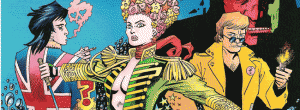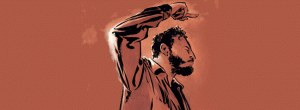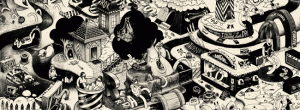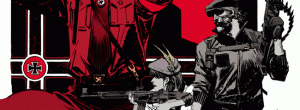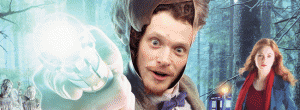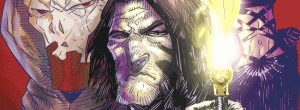Grant Morrison’s credentials as an acclaimed writer hardly need to be discussed. Yet despite his extensive bibliography, Morrison describes Joe the Barbarian as his first “true fantasy” tale.
In the best traditions of Narnia and Wonderland, Joe is an ordinary boy who journeys to a fantastical world. At first glance, it’s all a little too familiar: he is Windsor McKay’s Nemo, The Neverending Story’s Bastian. Another “Hero’s Journey” against a different background. Yet in Morrison’s hands, the classic quest narrative is brought into the modern world to create something utterly unique. Mature and sweet, steeped in visual metaphor, and with a world as fully realised as Tolkein’s but condensed into an afternoon seizure, it’s impossible not to be swept away.
In the first issue, Morrison lingers in the lonely reality of Joe’s everyday life, giving us time to identify with a boy growing up too fast: a father killed in Afghanistan, a house under threat of repossession, and problems at school. Even as he begins to slip away into his hypoglycemic hallucination, Joe can’t escape these issues; when he arrives in his fantasy world, the great battle is already lost. His innocence is in flames, the toy soldiers of his childhood defeated by the forces of King Death. In order to bring light to the kingdom once again, all he has to do is get from his attic to the basement. But in his hallucinatory state, this becomes an epic quest from Skyland to sunless Hypogea, aided by his samurai rat bodyguard Jack. (Don’t you just want to read it from that one sentence?)
It’s in the way these worlds interact that Morrison’s ideas shine through. Capturing that childlike imagination necessary for such pastimes as “the floor is hot hot lava,” Joe’s house unfolds into an incredible landscape: coats on hatstands become screeching undead knights, leaking taps create majestic waterfalls, and lightning strikes are the voices of gods. That sense of irreversible corruption pervades though, and a melancholy note gives Joe’s beautiful world a sense of real danger.
For all Grant Morrison’s ideas, the true star of this comic is Sean Murphy. It’s his artwork that makes you want to pour over depictions of these bizarre places, to uncover the symbolism hinted at in the narrative, to cheer for Joe and Jack as they struggle onwards. His occasionally cartoon-like style is lent a dynamism and maturity by the innovative use of ink. Scratched lines, hyper-kinetic splatters, confident brushstrokes, half-tone screens, and even thumb-prints are used to render Joe’s collapsing childhood. Deep areas of black coalesce alongside intricate submarine battles, sweeping castles, and treacherous swamps. Even the more domestic environment of Joe’s house, at risk of being overwhelmed by its illusory counterpart, is crafted with a loving eye to detail. Murphy’s
mastery of his angular figures and their expressions are no less impressive. All these abilities mark him out as one of the most important contemporary artists in comics.
Credit must also be given to Dave Stewart, the colourist who further enriches Murphy’s work, and the narrative as a whole. The watercolour textures and gradients are overlaid with bold acrylic-like painting, and liberal use of half-tone screens, mirroring Murphy’s use of them at the inking stage. Stewart’s contribution shines through in the way that he uses colours to distinguish between the two worlds. His muted palette of neutrals in the mundane, and the saturated vibrant riot of colour when we enter Joe’s, become a visual signal. When he uses this control to eventually blur the boundaries between worlds , the reader is all the more unsettled.
Fans of the series had to wait until Morrison finished his work on Batman: The Return of Bruce Wayne before getting their hands on the eighth and final issue. It seems too cruel that having waited six months for the end of Joe the Barbarian that it would disappoint, but it does. For having come so far as a rare gem, the final issue is pock-marked by some cheesy dialogue that cheapens the fantasy world and bizarrely, the introduction of new characters. Joe and Jack are as well-realised as they can be in a narrative contained to eight-issues and packed with so many visuals. But this additional space could have easily been used to flesh-out the minor players. Worst of all, in the last few pages, it falls back into a familiar cliché many tales like it have succumbed to. After the gorgeous hallucinatory world, an ending which harkens back to the mundane has hardly any emotional resonance. It will leave you hungering for a more unexpected, intelligent conclusion.
In the end, the praise far outweighs the criticism. Joe the Barbarian is a series for those who love visual storytelling, and the density of information it affords. Each page is a highly considered composition unto itself, alternating between lingering silence and ocular caffeine. Subtle allusions and metaphors permeate the tale, but Morrison and Murphy never allow them to slow down the action. It’s up to the reader how long they peer into Joe’s hallucination. So please, while you read, pause, and drink in the detail. You’ll want to stay in the Dying Boy’s world for as long as you can.
Joe the Barbarian will be released in hardback September 2011
Tom Hunt.
Ed – Just thought I’d say, Tom Hunt is an awesome comics creator as well as the author of this fine review, find his comics HERE.




